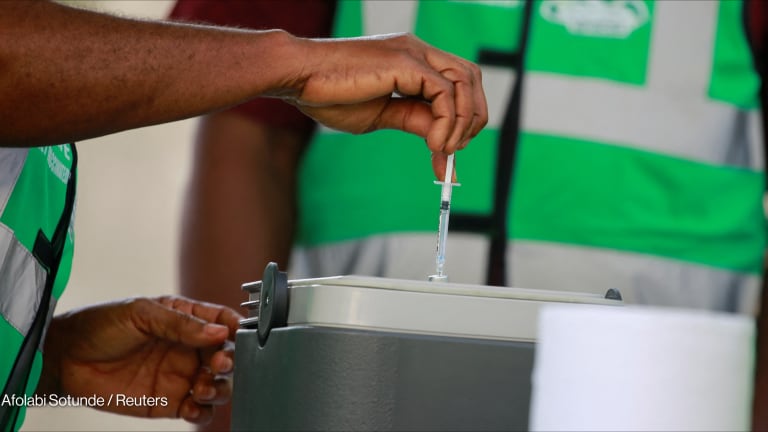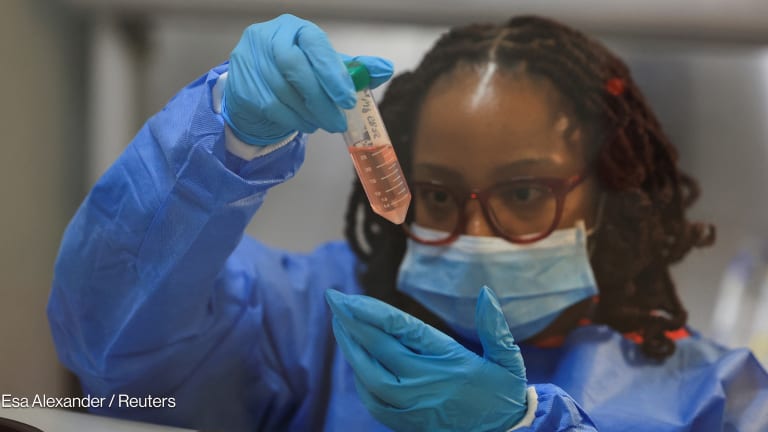
The death of Dr. Rosemary Chukwudebe, then head of the internal medicine department at Nigeria’s Kogi State Specialist Hospital in 2018 inspired Nigerian entrepreneur Temie Giwa-Tubosun to launch the medical oxygen business arm of her company LifeBank, which is well known for its blood supply services.
The must-read weekly newsletter for exclusive global health news and insider insights.
“She [Chukwudebe] needed oxygen and they eventually found the oxygen after many hours but they could not find a spanner to open the cylinder. And this woman died,” Giwa-Tubosun said. “I have her picture on my wall in my office here to remind me why I do what I do.”
Unfortunately, Chukwudebe’s predicament is a familiar one in many countries in the African continent where patients with asthma and other conditions have died because they could not get the medical oxygen they urgently needed.
Though the COVID-19 response has had a positive impact on Africa’s medical oxygen sector, health experts said the gains made during the pandemic should be sustained in the long term.
Prior to the COVID-19 pandemic, only two African countries — Ethiopia and Nigeria — had national oxygen policy road maps.
According to Nigeria’s National Policy on Medical Oxygen in Health Facilities, more than 625,000 deaths occur annually due to diseases associated with hypoxaemia, which is the insufficiency of oxygen in the blood or low blood oxygen saturation.
For children, hypoxaemia is a fatal complication resulting from pneumonia, which is the leading cause of death for children under 5, claiming an estimate of 120,000 lives annually. Furthermore, 25% of neonates and approximately 12% of children ill with pneumonia are hypoxaemic upon admission to the hospital, according to the report.
But a study by the Clinton Health Access Initiative in 2016 found that out of 169 hospitals that were assessed in eight Nigerian states, only 55% provided oxygen therapy. In addition, only 17% of pediatric wards assessed provided oxygen therapy, and pulse oximeters — which measure the amount of oxygen in a person's blood — were found in just 11% of the hospitals assessed.
Regionally, there were 68 oxygen generating plants, and 2,600 oxygen concentrators on the continent at the beginning of the pandemic — within a year this increased to 119 and 6,100 respectively. But this was still not enough to meet the demand created by the COVID-19 pandemic.
Dr. Matshidiso Moeti, the World Health Organization’s regional director for Africa, said during a WHO press conference back in 2021 that African countries were only producing a third of the medical oxygen needed during the third wave of the COVID-19 pandemic.
“The number one priority for African countries is boosting oxygen production, so we can give critically ill patients a fighting chance,” she said.
In response, several African countries including Nigeria, Somalia, and Uganda introduced interventions geared toward expanding access to medical oxygen.
At the onset of the pandemic, none of the public hospitals in Somalia had medical oxygen available. But WHO and other partners have since procured and installed pressure swing adsorption oxygen plants for large specialized hospitals, solar-powered medical oxygen systems for small hospitals, and oxygen concentrators for primary health centers.
In Uganda, only 36% of facilities offering services for chronic respiratory diseases had oxygen available before the pandemic. But Moeti said the procurement of more than 300 oxygen regulators has since eased the pressure on intensive care units in the country.
Nigeria’s minister of health, Dr. Osagie Emmanuel Ehanire, added that his government repaired oxygen production plants across the country and worked with industrial oxygen producers to repurpose industrial oxygen plants to produce medical grade oxygen — increasing the country's production from around 30 functioning production plants to over 70.
“We have also been working with the Nigerian Air Force which has a large oxygen production plant to supply oxygen at all points of need in the country,” he said.
Dr. Bruce Aylward, the ACT-Accelerator hub lead, said investments in medical oxygen in Africa, including new oxygen plants, will expand the capacities to be able to treat not just COVID-19 but other diseases as well. “These will have a longer-term investment impact,” he said.
Andrew Johnston, director of medical oxygen at Build Health International — a Boston-based company that provides infrastructure solutions for fragile health systems — said though COVID-19 has shined the spotlight on medical oxygen and brought resources into the sector sustained funding will be needed beyond the pandemic.
“We think that oxygen is an essential medicine, and it's part of good health care,” he said. “We certainly hope that we continue to get funded and that funding continues for medical oxygen globally after the pandemic.”
Giwa-Tubosun added that self-sustenance of the oxygen supply sector will also go a long way in ensuring that the gains of the COVID-19 pandemic are sustained in the long term. Adding that the sector now has a good business proposition, is in high demand, and has room for innovation.
“For us, the impact is most important, But on the business side, we of course want to be sustainable. We want to grow to scale. It definitely makes a lot of business sense,” she said.









